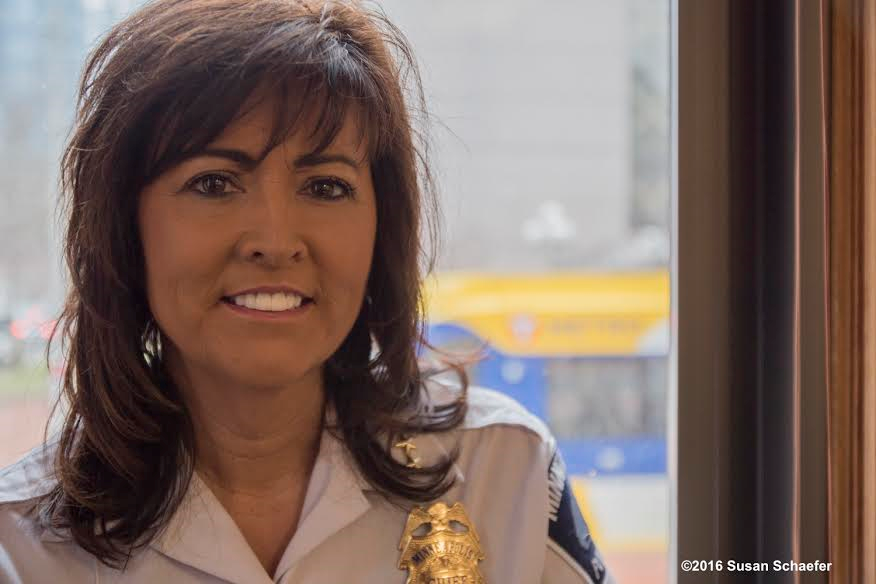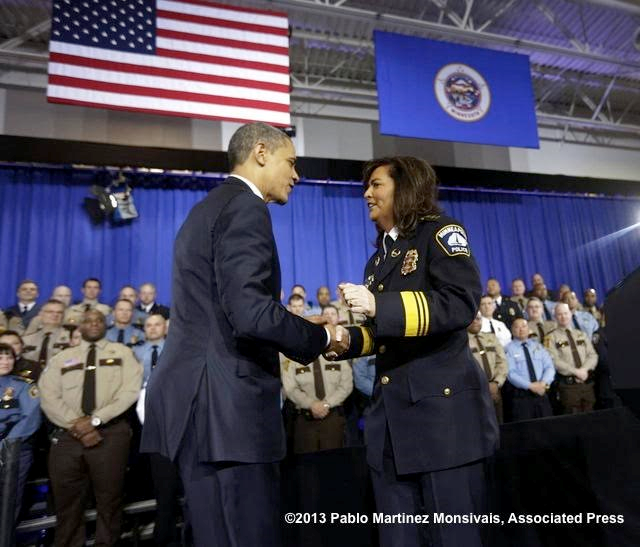The Paradox of Leadership: The Trials and Triumphs of Minneapolis Police Chief Janeé Harteau
 Monday, March 28, 2016 at 5:30AM |
Monday, March 28, 2016 at 5:30AM |  Susan Schaefer |
Susan Schaefer | By Susan Schaefer

An unexpected soft spring snowstorm yielded to a maelstrom of public and media criticism for Minneapolis Police Chief Janée Harteau last week. In a press conference and video release, she stated that disruptive actions would not be tolerated in anticipation of Hennepin County Attorney Mike Freeman’s upcoming decision about police culpability in the shooting death of Jamar Clark. Her hard line announcement sparked an angry response.
The tone of Chief Harteau’s pronouncement felt paradoxical in light of our interview the day before focusing on two topics: National and international attention regarding the positive impact of women’s leadership in policing and defense; and her heralded role in improving the culture and accountability within the Minneapolis Police Department (MPD).
International gender equality movements in policing and defense are on the rise following the United Nations Security Council Resolution 1325 – Women, Peace and Security (UNSCR 1325) that calls for gender equality in “representation and full involvement in all efforts for the maintenance and promotion of peace and security.”
“Over the last 40 years, studies have shown that female officers are less authoritarian in their approach to policing, less reliant on physical force and are more effective communicators. Most importantly, female officers are better at defusing potentially violent confrontations before those encounters turn deadly.” (Washington Post)
For some, her recent actions turned this assessment on its ear.
The apparent disconnect between Chief Harteau’s missive on zero tolerance for violence and her highly acclaimed mission to transition the MPD into a model of 21st century policing seems ironic.
In 2013 President Barak Obama personally acknowledged her work, inviting her to introduce him when he commended the MPD for its success in reducing gun violence.
Chief Harteau’s strategic policing platform, MPD 2.0: A New Policing Model, is a substantive internal management program with an overarching goal of creating an internal departmental culture of accountability, commitment, integrity and transparency. Its six pillars – Building Trust & Legitimacy, Policy & Oversight, Technology & Social Media, Community Policing & Crime Reduction, Training & Education, and Officer Wellness & Safety – align well with President Obama’s own initiative for 21st Century Policing. The MPD is one of the nation’s six cities chosen for the National “Trust & Justice” Initiative by the U.S. Attorney General.
Locally, too, she won high marks for her efforts. This past February Harteau was unanimously reappointed by City Council to a second term. While she has strong detractors, particularly in light of her handling of the Clark incident, the Star Tribune reported that at her reappointment hearing, “Harteau’s supporters outnumbered opponents 2-to-1…. Mayor Betsy Hodges said Harteau deserves credit for a proactive approach to policing befitting a ‘21st-century police chief’ and said the chief was working toward greater transparency and accountability.”
These efforts represent a Chief credited for working alongside multiple internal and external stakeholders for the past years, creating new outreach initiatives such as a Community Engagement Coordinator position, Community Engagement Team, and Youth Leadership Advisory Council.
More visibly, she is recognized for changing the face of MPD’s top leadership – promoting and recognizing overall diversity along with qualifications.
“My role is to create an effective team,” Harteau states, “and part of doing so has been to ensure that our force and our leadership better reflect the communities we serve.” The new top leadership roster does just that.
Her own appointment in December 2012 as 52nd Minneapolis Police Chief marked a number of precedents in diversity: Harteau was the first female, openly gay (with a teenaged daughter, later marrying her long time partner), and mixed race (French-Canadian/Native American) police chief in Minneapolis. She rose through the ranks on merit, beginning as a beat cop in 1987, with stints as Precinct Inspector, Deputy Chief of the Patrol Bureau, and Assistant Chief along the way.
“However, once you reach the top the real work begins,” she knowingly remarks.
As if to prove that point, in 2013, just after assuming her new post, she reached out to the U.S. Department of Justice (DOJ) for an independent assessment and assistance to enhance the MPD’s daily operations and performance.
This was a bold stroke.
Having submitted to federal oversight and scrutiny voluntarily, before the spate of high profile negative police-community relations’ incidents occurred, she began in earnest the tough job of building public trust.
The rating from DOJ ranked the Department “ahead of the curve in many areas,” but recommended changes in many others. At her reappointment hearings this past February she asked for and was granted time to continue the improvements.
“The public does not see the tremendous good outcomes of police work. The Department answers over a half million calls a year,” she emphasizes. That is the equivalent of almost 1400 calls a day – many life and death situations. Granted, organizational leadership does not garner headlines. Controversy does.
“The public doesn’t see the officers who, on their own time, provide a ride home for someone who is stranded. They don’t hear about the ones who buy shoes and gloves for the homeless from their own funds; when Department members don Santa hats and pass out gifts at the holidays, we don’t make the news. No one reported about the officer who adopted an abandoned child. These events define our life, our work, but they aren’t newsworthy. We need to tell these stories.”
“We are only as good as the tools on our belt, and by that I don’t mean the weapons we carry,” she continues. “I don’t want to have to arrest. I want to promote public safety before the crime. And that’s what I’ve set out to do.”
If her intention was to derail potential uproar if Hennepin County’s verdict upsets the activists, she missed the mark. City Council Member Cam Gordon acknowledged that while she may have had good intentions, her delivery failed.
“One of the best paradoxes of leadership is a leader's need to be both stubborn and open-minded,” says Simon Sinek, leadership expert and TED Talk darling. “A leader must insist on sticking to the vision and stay on course to the destination. But he [sic] must be open-minded during the process.”
With MPD 2.0, Chief Harteau has created a solid foundation for “a new policing model.” Our city will win if she strikes this leadership balance, finding a path that disarms her critics with wise choices.
Susan Schaefer can be reached at susan@millcitymedia.org.

